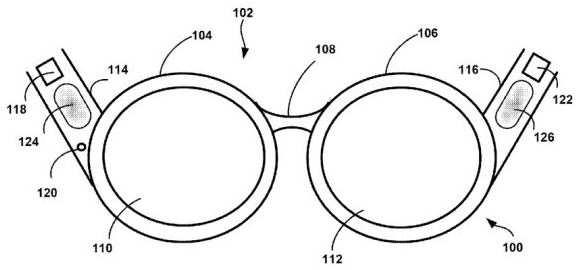Project Glass May Have Indirect Bone Conduction Speaker
Google is proposing bone conduction to deliver audio in Project Glass.
Up until now, there was no indication of how Google's Project Glass would provide sound to the user. After all, if you're going to make calls using the AR specs, you need to hear what the other person has to say (unless it's a good scolding of course – that calls for a dose of quick muting). Will the user wear earbuds connected to the specs in order to receive sound? Will there be external speakers just loud enough for the user to hear?
According to a patent filed by Google, the company proposes using bone conduction to deliver sounds. This will be done using elements embedded within the Project Glass specs that will vibrate the frames. In turn, that vibration will reach the user's skull and pass the sound down into the user's inner ear.
Google calls this method "indirect" because the specs don't directly vibrate your bones. Instead, the frames act as a transport mechanism which actually brushes up against your nose, your ears, your cheek bones, your temples and more. Where the vibrations will actually enter the skull is unknown at this point, but this could possibly be a setting within Project Glass, allowing the user to pick the best audio "reception" point.
The patent, called "Wearable Computing Device with Indirect Bone-Conduction Speaker", was actually filed on October 10, 2011, but made public on January 24, 2013. The abstract states that the specs will include at least one vibration transducer that is configured to vibrate at least one portion of the specs based on the audio signal. Does that mean a stereo reception will require an element on both sides of the head?
Bone-conducting headphones have been around on the consumer market for quite a while. For example, Outi introduced a pair back in 2007 that resembled a pair of clip-on earrings. Sound was reverberated through the earlobes, passing tunes through the user's cartiledge instead of the air. And during CES 2013, Panasonic introduced a Bluetooth pair that delivered sound through the user's temples.
Wikipedia defines bone conduction as "the conduction of sound to the inner ear through the bones of the skull." Our skulls conduct lower frequencies better than air, and that's why our voice sounds different when it's recorded and played back.
Contact Us for News Tips, Corrections and Feedback
Get Tom's Hardware's best news and in-depth reviews, straight to your inbox.

Kevin Parrish has over a decade of experience as a writer, editor, and product tester. His work focused on computer hardware, networking equipment, smartphones, tablets, gaming consoles, and other internet-connected devices. His work has appeared in Tom's Hardware, Tom's Guide, Maximum PC, Digital Trends, Android Authority, How-To Geek, Lifewire, and others.
-
A Bad Day Parsiansounds very neat but im not sure if that will have any health side effect.Reply
Well, every time you speak, your skull vibrates a little bit. That's why people usually don't recognize their own voice if it was played on a record, because the skull vibration from the talking affects the auditory system. -
Parsian A Bad DayWell, every time you speak, your skull vibrates a little bit. That's why people usually don't recognize their own voice if it was played on a record, because the skull vibration from the talking affects the auditory system.Reply
that is true, but the intensity varies. I wonder if it influences your nerves to act funny after a while. I mean, right now, not many people use such devices, but who knows what it could do to you health wise. But then again, using your keyboard and mouse for long duration will have health issues as well.
-
acktionhank Parsiansounds very neat but im not sure if that will have any health side effect.Reply
Take a peice of straw (as in hay) and clench it tightly between your teeth. Then align the other end of that same blade of straw onto a record player. You will "hear" the music, in your head, It's quite a neat trick.
I believe it's the same concept. -
scythe944 No health side effects, just sounds a bit different. I am tone deaf, have been since I was 5 due to a bike accident and a recent visit to a audiologist suggested to use a device like the one google might be putting into their headset to test how well I'd be able to hear if I had an implant. It actually allowed me to hear with my good ear covered up with my hand, which is something I haven't been able to do in over 20 years. It kinda sounded like I was in a tunnel, but I could hear!Reply
They make implants that do the same thing, only they're mounted into your skull. Obviously, I wasn't too keen on that and since I still have one good ear I skipped out but the concept is the same.
Basically, your ear hears in two ways: Sound pressure waves and bone vibrations. If the hairs inside your inner ear don't work, you could use the bone part of your hearing instead.
I think it's pretty cool stuff and might even allow me to listen to music with two ears again. Liking this device more and more... -
Parsian scythe944No health side effects, just sounds a bit different. I am tone deaf, have been since I was 5 due to a bike accident and a recent visit to a audiologist suggested to use a device like the one google might be putting into their headset to test how well I'd be able to hear if I had an implant.They make implants that do the same thing, only they're mounted into your skull. Obviously, I wasn't too keen on that and since I still have one good ear I skipped out but the concept is the same.Basically, your ear hears in two ways, sound pressure waves and bone vibrations. If the hairs inside your inner ear stop working, you could use the bone part of your hearing instead.I think it's pretty cool stuff and might even allow me to listen to music with two ears again. Liking this device more and more...Reply
thanks for sharing. To be honest, I didnt know they had such "headphones". Ive seen the speakers before where you can mount them to any surface and they use the vibrations of the surface to generate the sound. -
mayankleoboy1 Parsiansounds very neat but im not sure if that will have any health side effect.Reply
If we listened to more people like you, no tech advance can ever be made. -
sonofliberty08 MGS codecReply
Snake: This is Snake... Colonel... Can you hear me ?
Roy Campbell: Loud and clear...... -
ben850 My dad used "bonephones" (Bone Conduction Headsets) for decades in the Navy. I assure you he hears just fine now, although he's getting to be a little loony with his old age.Reply
